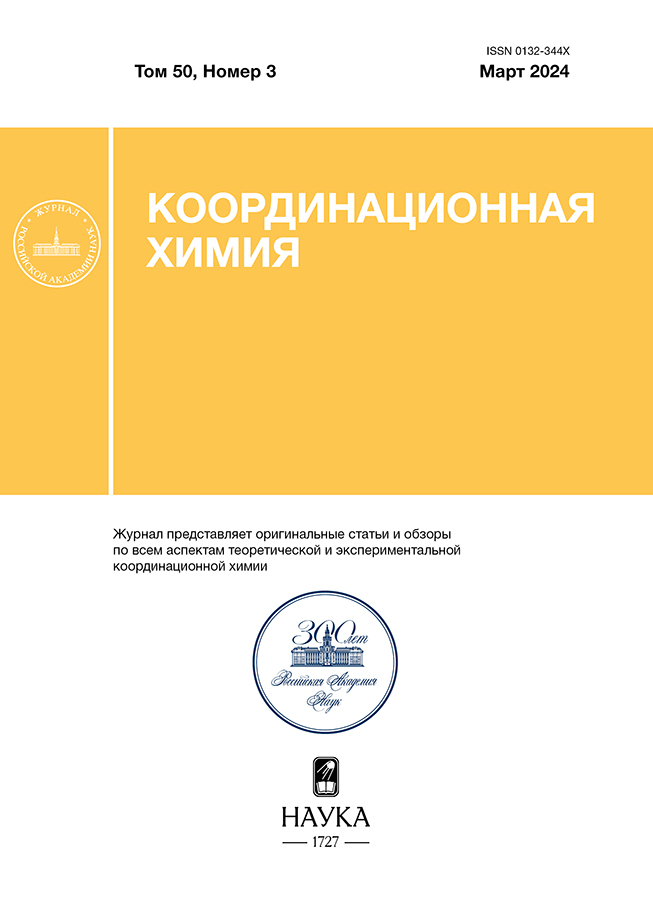New cobalt complex with dihydroxycoumarin: synthesis and kinetics of its redox-activated dissociation
- Authors: Spiridonov К.А.1,2, Nikovskii I.A.2, Antoshkina Е.P.2,3, Khakina E.А.2, Nelyubina Y.V.2
-
Affiliations:
- Moscow State University
- Nesmeyanov Institute of Organoelement Compounds, Russian Academy of Sciences
- Moscow Institute of Physics and Technology (National Research University)
- Issue: Vol 50, No 3 (2024)
- Pages: 200-208
- Section: Articles
- URL: https://rjeid.com/0132-344X/article/view/667613
- DOI: https://doi.org/10.31857/S0132344X24030059
- EDN: https://elibrary.ru/NSJRPD
- ID: 667613
Cite item
Abstract
A new redox-active cobalt(III) complex containing the 2-oxo-2Н-chromene-6,7-diolate dianion and 4,4ʹ-dimethoxy-2,2ʹ-bipyridine as ligands is synthesized. The reduction of the sythesized complex with ascorbic acid in an inert atmosphere is studied in situ by NMR spectrocopy. The reduction is shown to result in the release of 6,7-dihydrocycoumarin acting as a model drug. This process has the first order with respect to the initial complex.
Full Text
About the authors
К. А. Spiridonov
Moscow State University; Nesmeyanov Institute of Organoelement Compounds, Russian Academy of Sciences
Email: khakina90@ineos.ac.ru
Russian Federation, Moscow; Moscow
I. A. Nikovskii
Nesmeyanov Institute of Organoelement Compounds, Russian Academy of Sciences
Email: khakina90@ineos.ac.ru
Russian Federation, Moscow
Е. P. Antoshkina
Nesmeyanov Institute of Organoelement Compounds, Russian Academy of Sciences; Moscow Institute of Physics and Technology (National Research University)
Email: khakina90@ineos.ac.ru
Russian Federation, Moscow; Moscow oblast, Dolgoprudnyi
E. А. Khakina
Nesmeyanov Institute of Organoelement Compounds, Russian Academy of Sciences
Author for correspondence.
Email: khakina90@ineos.ac.ru
Russian Federation, Moscow
Yu. V. Nelyubina
Nesmeyanov Institute of Organoelement Compounds, Russian Academy of Sciences
Email: khakina90@ineos.ac.ru
Russian Federation, Moscow
References
- Brown J.M., Giaccia A.J. // Cancer Res. 1998. V. 58. P. 1408.
- Xiong Q., Liu B., Ding M. et al. // Cancer Lett. 2020. V. 486. P. 1.
- Vaupel P., Thews O., Hoeckel M. // Med. Oncology. 2001. V. 18. P. 243.
- Ruirui L., Feifei P., Jia C. et al. // Asian J. Pharmaceutic. Sci. 2020. V. 15. P. 311.
- Renfrew A.K. // Metallomics. 2014. V. 6. P. 1324.
- Hall M.D., Failes T.W., Yamamoto N. et al. // Dalton Trans. 2007. P. 3983.
- Palmeira-Mello M.V., Caballero A.B., Ribeiro J.M. et al. // J. Inorg. Biochem. 2020. V. 211. P. 111211.
- Tsitovich P.B., Spernyak J.A., Morrow J.R. // Angew. Chem. Int. Ed. 2013. V. 52. P. 13997.
- Renfrew A.K., O′Neill E.S., Hambley T.W. et al. // Coord. Chem. Rev. 2018. V. 375. P. 221.
- McPherson J.N., Hogue R.W., Akogun F.S. et al. // Inorg. Chem. 2019. V. 58. P. 2218.
- Khakina E.A., Nikovskii I.A., Babakina D.A. et al. // Russ. J. Coord. Chem. 2023. V. 49. P. 24. https://doi.org/10.1134/S1070328422700105
- Vlcek A.A. // Inorg. Chem. 1967. V. 6. P. 1425.
- Ma D.-L., Wu C., Cheng S.-S. et al. // Int. J. Mol. Sci. 2019. V. 20. P. 341.
Supplementary files


















